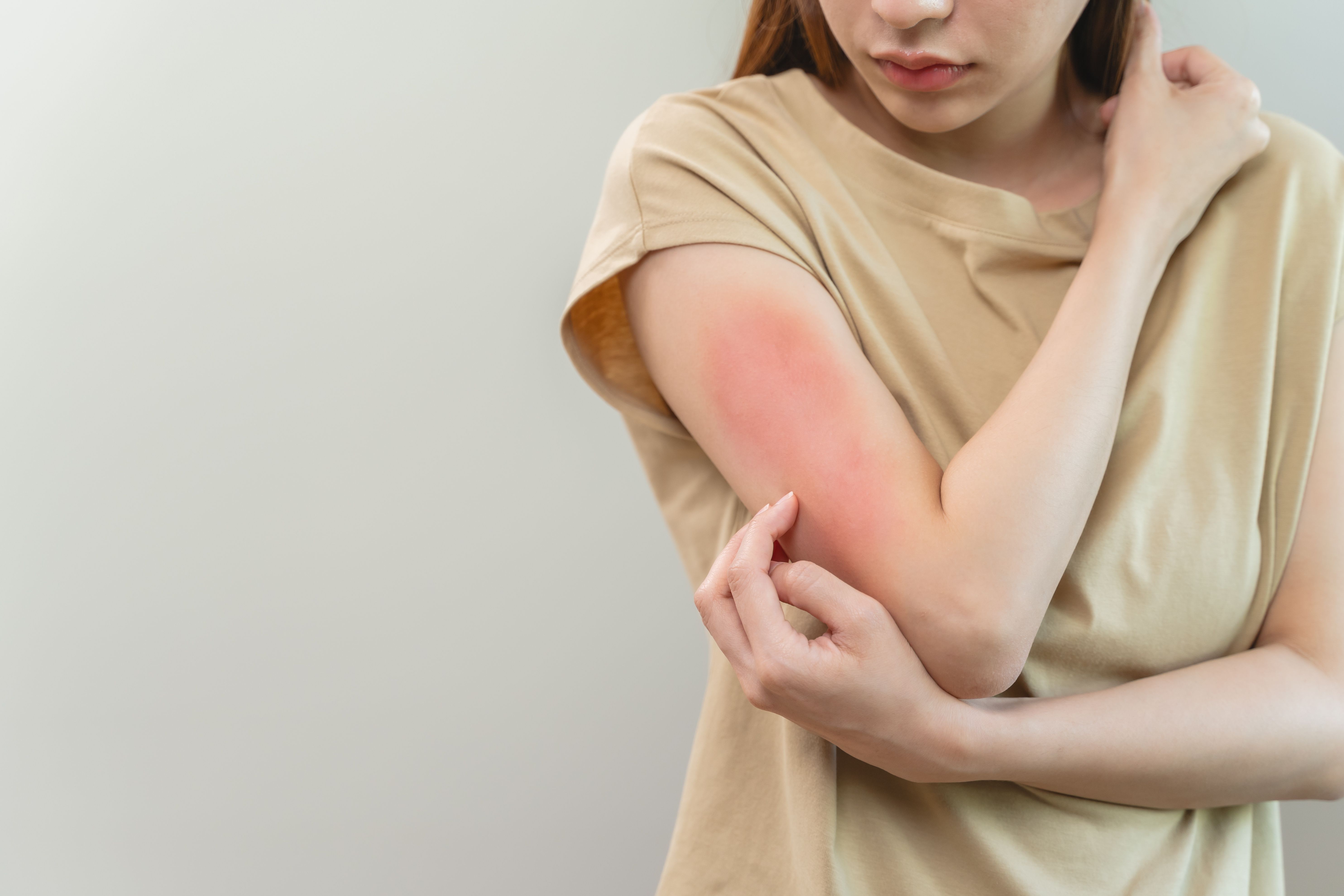News
Article
AI-Enabled Wearable Sensor Reduces Scratching in Atopic Dermatitis
Author(s):
Key Takeaways
- AI-enabled wearable sensors can significantly reduce nocturnal scratching in patients with mild atopic dermatitis through haptic feedback.
- The study demonstrated high accuracy, sensitivity, and specificity in detecting scratching, with a 28% decrease in scratch events and 40% reduction in scratch duration.
Patients with mild atopic dermatitis who reported nighttime scratching experienced relief when they used an artificial intelligence (AI)-powered wearable sensor that delivered haptic feedback on sleep behaviors.
Patients with mild atopic dermatitis who reported nighttime scratching experienced relief when they used an artificial intelligence (AI)-powered wearable sensor that delivered haptic feedback on sleep behaviors. | Image Credit: Pormezz - stock.adobe.com

An artificial intelligence (AI)-enabled wearable sensor may reduce nocturnal scratching among patients with atopic dermatitis (AD) and self-reported moderate or severe scratching behaviors, according to a study published in JAMA Dermatology.1
AD, the most common subtype of eczema, can cause dry, inflamed skin, resulting in pruritus, informally known as itchiness.2 Practitioners recommend preventative measures such as moisturizing routines, daily bathing habits, and avoiding fragrances to reduce symptoms. If preventative measures are ineffective, patients can use stronger prescription medication.
Patients with AD often experience a scratch-itch cycle that leads to worsening skin inflammation.1 Significant itchiness and scratching can impact sleep patterns, contributing to morbidity. While there are many pharmacologic treatments available for AD, nonpharmacological treatments are limited.
“There is a need for nonsystemic interventions for patients with mild skin involvement but high degrees of self-reported itch and scratching,” study authors stated.
Another challenge the authors noted is that there are few objective ways to quantify itchiness in this patient population.
“The criterion-standard method of direct visualization of scratching by video recording is impractical in real-world settings,” the authors wrote. “Other forms of monitoring, such as actigraphy wrist-mounted devices, have lower sensitivity in finger-dominant scratching. More recently, a flexible wearable device (ADAM sensor; Sibel Health) mounted on the dorsal hand in conjunction with a previously validated artificial intelligence–driven scratch algorithm was shown to have high sensitivity and specificity in adult and pediatric patients with AD for detection of nocturnal scratching compared against infrared video recordings.”
The researchers conducted a retrospective analysis among patients with mild AD who reported moderate or severe scratching. In the study, a wearable sensor mounted on the hand delivered haptic feedback whenever its AI algorithm detected nocturnal scratching.
The primary end point of the study was to assess the efficacy of the closed-loop haptic feedback function in nocturnal scratch reduction. Primary outcomes included total scratch duration (TSD), total scratch events (TSEs), mean TSEs per night, mean TSEs per sleep opportunity hour, and mean scratch duration per scratch event.
The study included 10 patients, 6 of whom were female, and the average age of the participants was 36 years. The closed-loop AI-enabled system demonstrated an average 99% accuracy, 95% sensitivity, 99% specificity, and 97% F1 score among the 10 participants. All participants said the haptic motor alerted them to scratching events. The study encompassed 104 sleep nights and 831 monitoring hours.
Researchers recorded 60 nights during week 1, with an average nightly monitoring time of 6.4 hours. Participants generated about 96.5 seconds of TSD, 45.6 TSEs, and 2 seconds of scratch duration per scratch event. An additional 54 nights were recorded during week 2, for a mean nightly monitoring time of 7.5 hours. Participants generated about 58.1 seconds of TSD, 32.8 TSEs, and 1.75 seconds of scratch duration per scratch event.
Haptic feedback resulted in a mean 28% decrease in TSEs per night (45.6-32.8; P = .03) and a mean 40% reduction in average TSD per night (96.5 seconds-58.1 seconds; P = .04). After researchers normalized the haptic feedback by hour, they observed a mean 39% decrease in mean TSEs per sleep opportunity hour (7.4-4.5; P = .004) and a mean 50% decrease in mean TSD per sleep opportunity hour (15.8 seconds-7.9 seconds; P = .01).
Most participants found the device was easy to wear and use. All participants reported a desire to reduce scratch activity, and 8 participants desired a nonpharmacologic method to achieve this.
The study's small sample size limits its scope, and researchers should expand it to include pediatric patients, assess potential benefits for daytime scratching, and evaluate impacts on skin improvements. Additionally, the researchers suggested the presence of the AI device on the hand may have contributed to reduced scratching behavior, regardless of haptic feedback. The device only monitored the individual patient’s dominant hand, leaving the nondominant hand data uncaptured.
Regardless, the closed-loop system enabled a real-time intervention to address scratching behavior. Overall, the study cohort experienced a reduction in the duration of total and hourly scratch time at night and the number of total and hourly scratch events. Including a device sham arm, longer intervention periods, and more sustained follow-up assessments of both clinical benefit and scratching metric changes in future clinical trials could confirm the findings.
“This technology may serve as a standalone or, more likely, a supportive therapeutic device for decreasing scratching behavior in patients with mild AD who may not meet the criteria for systemic therapy or prefer to not use topical corticosteroids,” the study authors concluded.
References
- Yang AF, Patel S, Chun KS, et al. Artificial intelligence–enabled wearable devices and nocturnal scratching in mild atopic dermatitis. JAMA Dermatol. Published online February 05, 2025. doi:10.1001/jamadermatol.2024.5697
- Managing itch. National Eczema Association. Accessed February 7, 2025. https://nationaleczema.org/eczema/itchy-skin/





